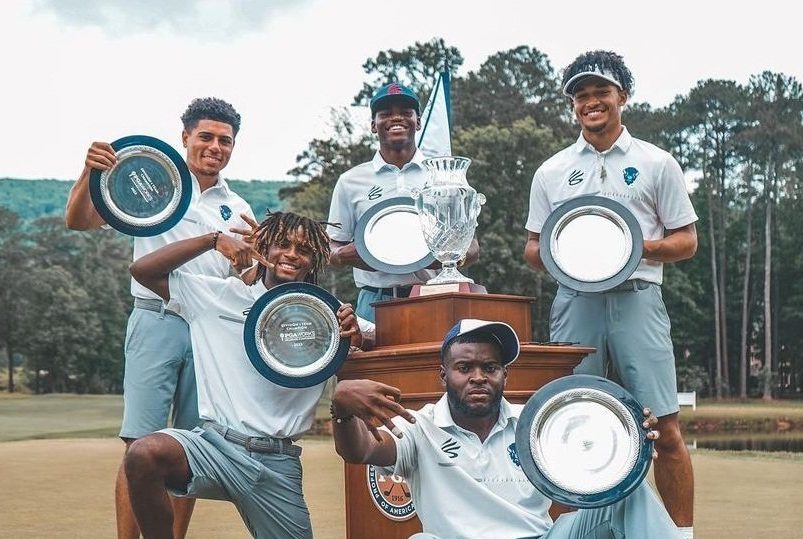Of all the golfers who have won the PGA Championship in the last 50 years, arguably none cherished the achievement more than Lee Trevino.
“The PGA of America gave me my life,” Trevino has said on numerous occasions. “That’s exactly what they did.”
Bill Eschenbrenner, the head professional at El Paso (Texas) Country Club for 35 years, helped Trevino when he moved there from Dallas in 1965 to obtain his PGA Class A card. When Trevino wasn’t busy winning money games, he was doing everything at nearby Horizon Hills Golf Club from opening the shop first thing in the morning to shining shoes to giving lessons. At the time, a pro was required to be a card-carrying member to play on the PGA Tour and Trevino’s previous boss in Dallas refused to endorse his work.
Eschenbrenner found another way through his local PGA chapter, and kept Trevino’s framed application from the Sun Country PGA Section – dated March 13, 1966 – on display in his pro shop until he retired in 1999 (and became pro emeritus).
106th PGA: Leaderboard | How to watch | Money | Sunday photos
“I had faith in him,” said Eschenbrenner, who said Trevino’s PGA Class A card came through a week before the Merry Mex finished fifth at the 1967 U.S. Open at Baltusrol, after which his playing career was off and running. “I said, ‘If he doesn’t make a good PGA member, you can take my card.’ ”
As one of the last bridges to the days when touring pros started their careers behind the counter of a pro shop, Trevino always had an ulterior motive for winning the Wanamaker Trophy. The PGA Championship meant more to him than it did to his rivals. And he succeeded — twice. Trevino won the title for the first time 50 years ago, then won it again 10 years later for his sixth and final major as well as 29th and final PGA Tour title.

Entering the 56th PGA Championship, held at Tanglewood Golf Club, a 36-hole public complex in Clemmons, North Carolina, Trevino had experienced little success in the championship. In six previous appearances, he had finished no better than 11th.
But he found the course – and the soggy conditions, which better enabled him to hold the course’s greens with his lower trajectory approaches – to his liking. More than seven inches of rain saturated Tanglewood in the days leading up to the championship and the thirsty turf sprang to life, resulting in unruly rough. “The grass was knee-high to a giraffe, and the greens had footprints this big,” recalled Trevino, holding his hands a foot apart.
The skies opened again as the first round got underway. All three of the first-round leaders benefited from afternoon tee times when the rain lifted. Hubert Green, the Tour’s number-two money winner at the time, birdied two of his last three holes to tie Raymond Floyd and John Schlee at 2-under 68. Despite competing in the better half of the draw, Trevino failed to take advantage and opened with a 3-over 73.
But in the second round, under still damp conditions, he signed for a nifty 66, and strolled into the press center and declared, “Ain’t nothin’ like a low round to make you un-tired.” That was the low round of the week until Gary Player delivered a PGA Championship record-tying 64 later that day. Trevino still trailed Schlee, the 36-hole leader, by four strokes.
On Saturday, the weather finally broke, but Schlee slid down the leaderboard with a 75. Player, who had won the Masters and the Open Championship earlier in the year, also fell to Earth with a 73. Trevino signed for a 2-under 68 and a 54-hole total of 3-under 207. Lurking one stroke back was Jack Nicklaus, who matched par with 70, and liked where he stood as he searched for his 13th major title.
The potential of another Nicklaus and Trevino mano a mano Sunday battle with a major on the line dominated the sports headlines. Lee already had gotten the better of Jack for three of his four major wins, including an 18-hole playoff in the 1971 U.S. Open and the 1972 Open Championship, which had spoiled Nicklaus’s Grand Slam quest. Player, for one, had a strong opinion on what made Trevino such a thorn in Nicklaus’s side.
“Lee Trevino had enough heart for 10 men,” Player said.
Two other players emerged as unlikely contenders after three rounds. Bobby Cole, a 26-year-old South African who was winless on Tour, shot 71, which left him one behind Trevino. And the legendary Sam Snead, at age 62 and nine years removed from the last of his Tour-record 82 career victories (since tied by Tiger Woods), was four back at 1-over after rounds of 69-71.
On Saturday, Trevino one-putted five of the last six greens, a feat that yielded a lovely story about how he acquired the club. It all began when Trevino rented a house for tournament week from Zana Mayberry, a widow who lived with her son near Tanglewood. A week before the championship, she stored some belongings in the attic, including her husband’s golf clubs. Trevino had peeked into the attic and discovered the set, pulling a Wilson Arnold Palmer 8802 blade putter from the bag. He had taken the club for a spin during his practice session, and it was love at first stroke. But Trevino didn’t think it would be proper to use it in the tournament without asking permission.
“She said it was her husband’s, who had died about six months before,” Trevino recounted. “She was going to save it for her son if he decided to play golf.”
But she granted Trevino permission to use it that week and it had been deadly.
Eight players were within three shots of Trevino’s lead when the final round began, but it quickly became clear that another Trevino-Nicklaus showdown was in the making – save for one party crasher. In the threesome immediately ahead of the two heavyweights, Cole briefly took the lead. At the first hole, a 380-yard, downhill dogleg left, his second shot from thick rough hit behind the hole, hopped back and disappeared for an eagle. It proved to be the start of a rollercoaster day for Cole, who made only five pars.

Trevino answered with an eight-foot birdie at the first, and the two co-leaders set the pace until Cole stumbled with a bogey at the ninth. He continued the chase, alternating birdies and bogeys, but a double bogey at 17 sealed his fate. He finished with a 71 and shared third with, among others, Snead. Playing in his 37th PGA, Snead closed with a 68 and became the oldest player to finish in the top five of a major championship.
Trevino was nursing a one-stroke lead over Nicklaus as they reached the 72nd and final hole of the championship. Likely needing a birdie to tie, Nicklaus reached the fringe of the green and couldn’t mark and clean his ball. He gave a valiant try, but his 20-foot birdie attempt slid by on the high side.
“It looked to me like it would break a foot, and it broke maybe an inch or two,” he said. “I think without the mud, it might have.”
After Nicklaus tapped in, Trevino lagged his putt within 2 feet of victory. It’s customary in such situations for the leader to mark his ball and allow his competitors to putt first. Green still had about four feet to clean up, but Trevino had other ideas. He asked if he could finish, wiggled it in for a textbook par, and had his fifth major title in a seven-year span.
Trevino, the former driving-range pro who had been deprived of his PGA membership, had won the association’s signature event.
“It felt like payback,” he said on the day of his 2015 induction into the PGA of America’s Hall of Fame. “[Eschenbrenner and the PGA] took a chance on me, and I fulfilled my commitment.”
As for “the Ms. Mayberry putter,” as he came to refer to it, the usually unsentimental Trevino made it one of the few keepsakes from his career. When he assumed the 54-hole lead, Ms. Mayberry told Trevino that he could have the putter if he won the championship. He tucked the gift away at home in a special drawer at home.
Twice is nice
The only thing better than having his name inscribed on the Wanamaker Trophy once was doing it a second time. Shoal Creek, host of the 1984 PGA Championship in suburban Birmingham, Alabama, was the type of unforgiving layout on which Trevino tended to excel. Much like at Tanglewood, Shoal Creek’s rough was the No. 1 topic of conversation.
“That was the toughest rough I’ve ever played in, including all the U.S. Opens,” Trevino said. “It was almost like having water hazards on both sides of the fairways.”
A late-afternoon thunderstorm emerged as the real winner of Round One, causing a suspension of play until Friday with 30 players yet to finish. Lanny Wadkins, who had one hole left to complete, eventually joined Mike Reid and Raymond Floyd as 18-hole co-leaders. The rain was to have a profound effect on the next three rounds, ensuring the greens never got hard and making conditions ideal for low scoring.
Once again, Trevino took advantage of a new putter in the bag. Three weeks before the PGA, during the first round of the Dutch Open, he hit every green in regulation yet shot 74 – thanks to taking 36 putts. Trevino hummed “Taps” to his wife, Claudia, his way of saying it was time to put his current putter out of its misery. She didn’t let her husband sulk for long, suggesting he try a Ping putter after noting that champion Seve Ballesteros and nearly all of the top 10 finishers in the 1984 Open Championship had used that brand. Her passionate urging prompted Trevino to visit the Rosensaelsche Golf Club pro shop and buy the only Ping model in stock, an A-Blade, for about $50. First, Trevino had to knock some sense into it. “I beat it against the concrete and stomped it with my heel until I got the loft and the angle I like,” he said.
It did the trick. In the early going, Trevino made only one bogey over the first 36 holes and holed five putts of 15 feet or longer, including a 45-foot bomb at the eighth on Friday. In the third round, he took six putts over the first seven holes and made the turn at 6-under 30. His 67 ran his recent form to 61 under par for the last 13 competitive rounds. But could his game hold up for one more day? He was a 44-year-old, part-time player stepping out of the broadcast booth with a surgically repaired back who hadn’t lifted a major championship trophy since Tanglewood a decade earlier.
Trevino got off to an auspicious start, sinking a 60-foot birdie putt at the first. But the feisty Wadkins loved nothing more than a fight and responded with birdies at the sixth and ninth to gain the outright lead for the first time. Player trailed by one stroke after jarring an uphill 60-foot birdie putt at the ninth, but he took three putts on the next hole and never drew closer than two shots the rest of the way.
The turning point proved to be the par-3 16th hole, where Wadkins, coming off birdie to trim Trevino’s lead to one, had the honor at the 197-yard hole. His tee shot came to rest within 15 feet of the hole. Next, Trevino tried to cut a 4-iron from the elevated tee, but yanked it left into the front bunker and did well to splash 15 feet past the hole. The pendulum looked about to swing in Wadkins’ favor, with possibly a two-shot swing.
But Trevino’s putter bailed him out once more, the ball slowing at just the right moment to curl in. To make matters worse, Wadkins missed his putt to tie and didn’t have an answer for the hot-putting Trevino, who birdied the final two holes for a four-shot victory.
As only Trevino could do, he paid tribute to his putting prowess at Shoal Creek by kissing his three-week-old Dutch treat and taking a bow. Then he did it three more times, turning each time to ensure everyone encircling the green got to see him face-to-face-to-face.
Trevino’s closing 69 made him the first player in PGA Championship history to shoot four rounds under 70, while his winning total of 15-under shattered the PGA’s previous under-par record by five strokes. He now had won a major championship in three different decades. Holding the silver Wanamaker Trophy aloft for the second time and ending a 40-month winless drought, Trevino said, “God, it’s shiny. It’s been a long time since I got something this shiny.”
Or that meaningful. Once he became one, Trevino never took being a PGA Class A member for granted. Whenever he’d go to a new course, he made a point of greeting the assistants and introducing himself to the head pro.
“That is courtesy,” Trevino said. “That is respect for the PGA professional.”






